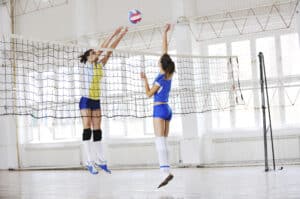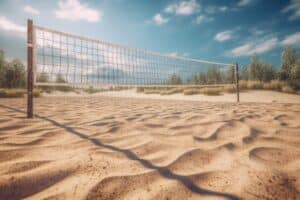How to Maintain a Sand Volleyball Court
Key Takeaways
- Regular cleaning and debris removal is crucial for maintaining a sand volleyball court’s condition and safety.
- Player safety should be ensured by removing sharp rocks or stones and checking and repairing equipment.
- Maintaining the court perimeter and surroundings, as well as regularly checking and repairing equipment, are important for a clean and playable area.
Maintaining a sand volleyball court is essential for its longevity and safety. Regular upkeep ensures that the court remains in optimal condition for players to enjoy the game. In this article, we will explore the best practices and tips for maintaining a sand volleyball court, based on information from various reputable sources.
Regular Cleaning and Debris Removal
One of the most important aspects of maintaining a sand volleyball court is daily cleaning and debris removal. Patrolling the court on a daily basis helps identify and remove any debris such as paper, cigarette butts, and bottle caps that may have accumulated. It is crucial to dispose of these items properly to keep the court clean and safe for players.
Raking the sand regularly is also necessary to bring up sharp objects and trash that may have settled. This helps to maintain a smooth playing surface and prevent any injuries caused by hidden hazards. It is recommended to rake the entire court, paying special attention to areas around the net where player activity is intense.
Ensuring Player Safety
Player safety is of utmost importance in any sport, and sand volleyball is no exception. To ensure a safe playing environment, it is crucial to remove any sharp rocks or stones that could cut players’ feet. Regular inspection of the court helps identify and eliminate these potential hazards.
In addition to the playing surface, it is important to check and repair any padding on poles or structures that players could run into. This helps prevent injuries from accidental collisions and ensures a safe playing experience for everyone involved.
Maintaining Court Perimeter and Surroundings
Clearing a 3- to 4-foot-wide perimeter around the court from trash, obstructions, and debris is essential for maintaining a clean and playable area. This perimeter should be regularly inspected and cleared to prevent any hindrance to the game and ensure a safe playing environment.
If grass grows within the perimeter, it is important to keep it mowed short. This helps maintain a neat appearance and prevents the grass from encroaching onto the playing surface.
Checking and Repairing Equipment
Regularly checking and maintaining the equipment associated with the sand volleyball court is crucial for its proper functioning and safety. Wooden posts where net anchors are attached should be inspected for wear. Any signs of wear should be addressed promptly by repairing or replacing the worn posts.
It is also important to periodically check the volleyball net for tears or damage. If any issues are identified, the net should be replaced to ensure fair play and prevent injuries.
Additional Tips for Maintenance
While the above practices cover the basics of sand volleyball court maintenance, there are a few additional tips that can help keep the court in excellent condition:
- Regularly sweep the court to eliminate dirt and debris.
- Use a special stain remover for sports surfaces to remove any spills or stains.
- Fill in small cracks or damages to prevent them from getting bigger.
- Use windbreakers to protect the court from erosion caused by strong winds.
- Keep indoor courts well-ventilated to prevent moisture build-up and potential damage.
- Use weather-resistant covers for outdoor courts to protect them from rain, snow, and sun.
- Regularly maintain and repair the court to ensure its longevity and safety.
- If needed, seek professional help for resurfacing or major repairs.
Following these recommendations and implementing a regular maintenance routine will help keep your sand volleyball court in excellent condition for years to come.
Related Websites:
FAQs:
Q: What are the benefits of playing on a sand volleyball court compared to other surfaces?
Playing on a sand volleyball court offers several benefits. The soft surface reduces impact and strain on joints, making it safer for players. The sand also provides a natural cushioning effect, reducing the risk of injuries from falls. Additionally, sand courts offer better traction, allowing players to make quick movements and dive for the ball with ease.
Q: Why is regular maintenance important for a sand volleyball court?
Regular maintenance is crucial for a sand volleyball court. It ensures player safety by addressing erosion, drainage issues, and preventing weed growth or pests. Maintenance also helps preserve the court’s aesthetics and functionality, preventing sand compaction and divots that could affect the game’s quality.
Q: How often should a sand volleyball court be maintained?
For optimal performance, it is recommended to maintain a sand volleyball court at least once a week. However, frequency may vary depending on factors like usage, weather, and court conditions. Regular upkeep throughout the year, such as raking and grooming, should be performed to keep the court in good shape.
Q: What are the necessary steps for maintaining a sand volleyball court?
To maintain a sand volleyball court, several steps should be followed. These include clearing debris and foreign objects, leveling the sand, raking and grooming the surface, watering and compacting the sand, and addressing erosion and drainage issues. Following these steps will ensure a well-maintained court for optimal play.
Q: How can common issues with a sand volleyball court be prevented and treated?
Common issues with a sand volleyball court can be prevented by regularly inspecting the court and addressing potential problems. This includes preventing weed growth and pests through proper maintenance techniques, handling drainage problems and standing water promptly, and repairing divots and filling low spots to maintain an even playing surface.






